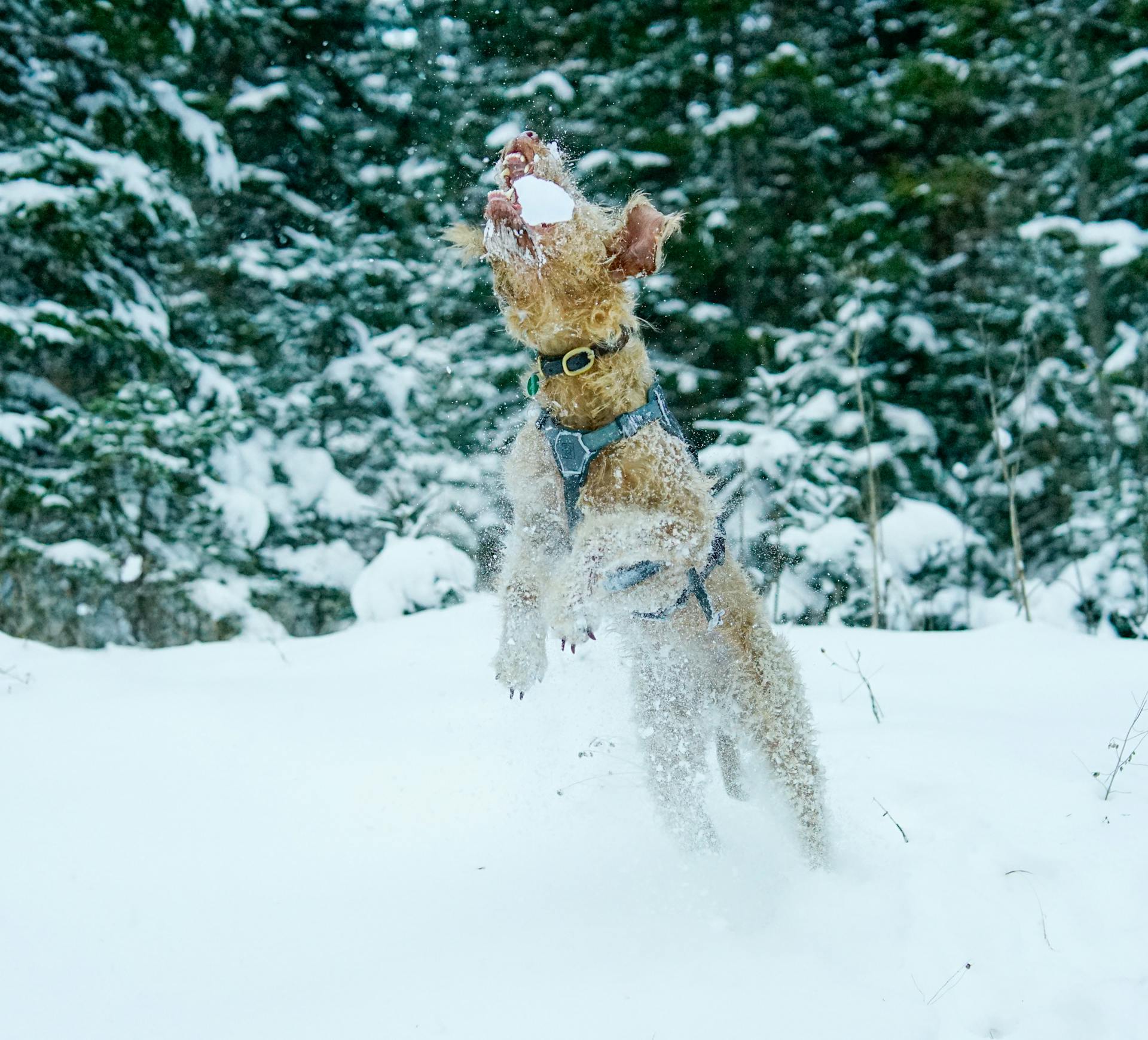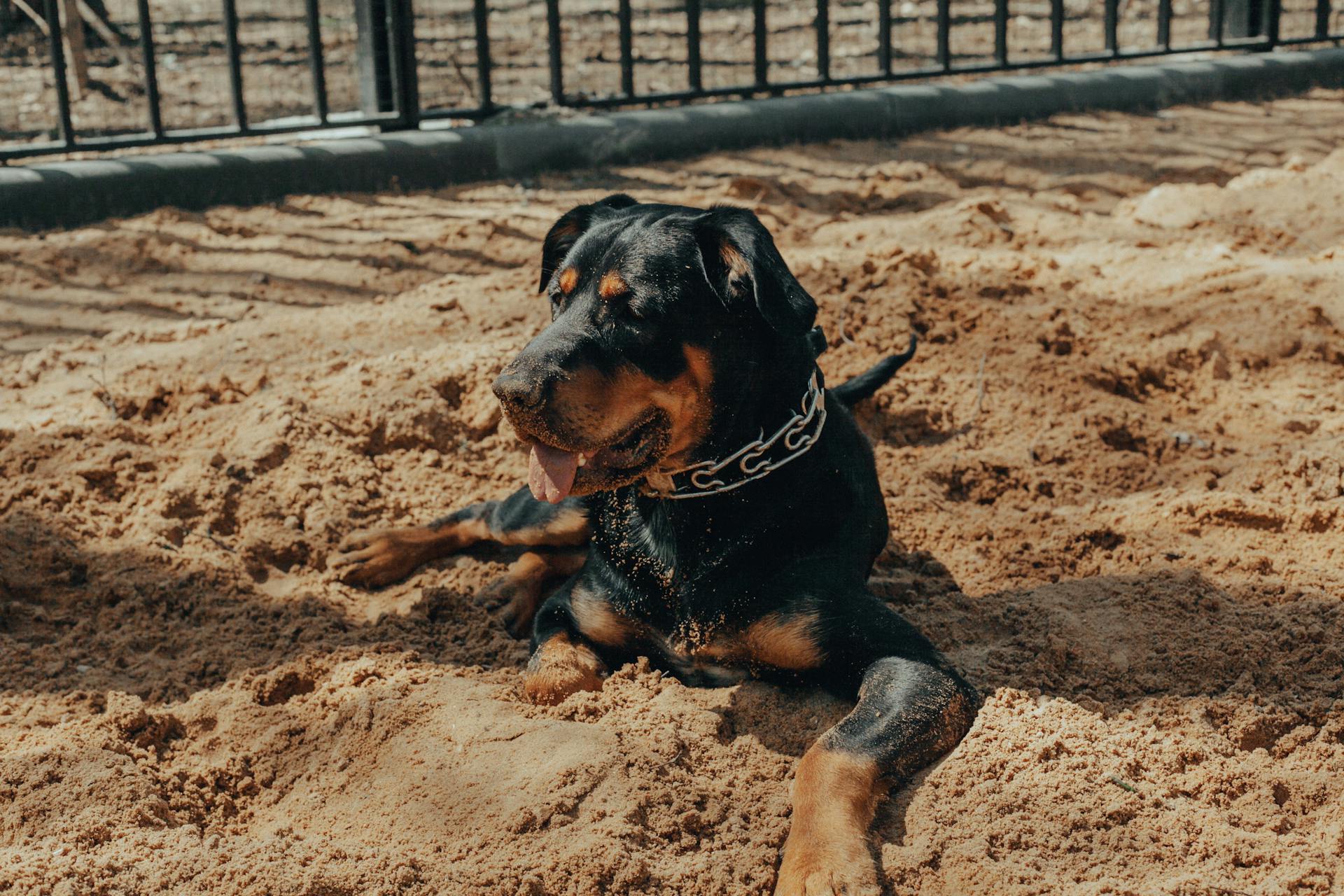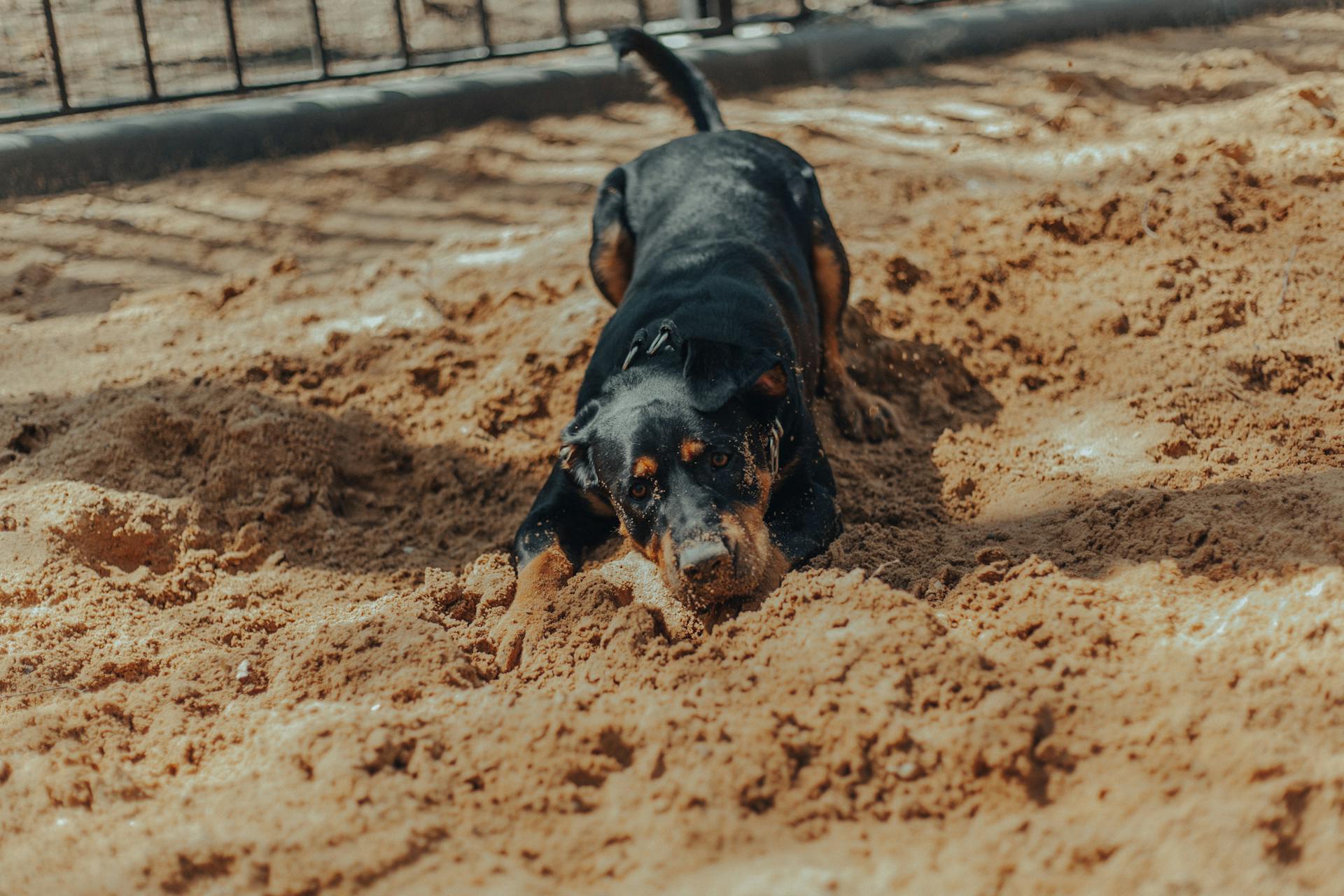
The Lakeland Terrier is a small but mighty breed that's perfect for families and individuals who want a loyal companion.
They originated in the Lake District of England in the 19th century, where they were bred to hunt small game such as foxes and badgers.
Lakeland Terriers are known for their distinctive bearded face and short, dense coat that requires regular grooming.
They weigh between 15-17 pounds and stand about 14 inches tall at the shoulder.
A Lakeland Terrier's energy level is moderate, requiring daily walks and playtime to keep them happy and healthy.
Characteristics
The Lakeland Terrier is a spunky and bold breed, known for their playful and sometimes mischievous nature. They're highly intelligent, which can sometimes make training a challenge.
One thing to note is that Lakeland Terriers have a high affection level, so they'll often want to be around their owners and receive attention. They're generally friendly, but not overly aggressive, making them a great companion for many families.
In terms of exercise needs, Lakeland Terriers require a moderate amount of physical activity to stay happy and healthy. They're not high-energy dogs, but they do need regular walks and playtime to keep them engaged.
Here's a breakdown of some key characteristics of the Lakeland Terrier breed:
Overall, the Lakeland Terrier is a lively and engaging breed that's sure to bring joy and companionship to many families.
History of the Lakeland Terrier
The Lakeland Terrier has a rich history that dates back to the 1700s, making it one of the United Kingdom's oldest terrier breeds.
Its name comes from the Lake District of Northern England, where it was bred to hunt vermin and protect livestock.
Farmers in the area used packs of terriers to exterminate pests and hunt foxes that threatened their sheep and other livestock.
The Lakeland Terrier's breed standard was honed in the early 1900s, and it's thought to have been influenced by breeds such as the Old English black and tan terrier and the Welsh terrier.
For more insights, see: How to Train a German Shorthaired Pointer to Hunt
The American Kennel Club first recognized the breed in 1934, and the United States Lakeland Terrier Club formed in 1954.
The breed was originally known as the Patterdale Terrier, and its early name was the Cumberland County Terrier.
World War I slowed development of the breed, but an official breed standard was established in the 1920s, and the breed was given its current name.
The Lakeland Terrier first appeared in the show ring in 1928 at Crufts in the United Kingdom, and its confident poise and undeniable handsomeness have made it an excellent show dog.
In 1967, a Lakeland Terrier named Champion Stingray of Derryabah was the first dog to win Best in Show at both Crufts and Westminster.
The breed has gone by several different names throughout its history, including the Fell, Patterdale, Cumberland, and Westmoreland terrier.
Lakeland Terriers are known for their fearlessness, pride, and intelligence, and they're still used today as working dogs to protect land and sheep.
The breed was recognized by the American Kennel Club in 1934, and it's also recognized by the United Kennel Club, which recognized it on January 1, 1995.
The Lakeland Terrier's hard-working attitude persists today, and it's still a popular breed among hunters and dog enthusiasts.
See what others are reading: Most Popular Dogs Breeds
Care
The Lakeland Terrier needs a fairly active lifestyle to stay happy and healthy. This means regular exercise, which can be as simple as a daily walk or playtime in the yard.
Their coat is relatively easy to maintain, but it does require some specific grooming to keep it looking its best. Regular brushing can help prevent matting and tangling.
Despite their independent nature, Lakeland Terriers thrive on attention and interaction with their owners. They need consistent training and socialization from a young age to become well-behaved and well-adjusted dogs.
Exercise will require an hour or more each day, and they may grow difficult if left alone for too long. This means that Lakeland Terriers are best suited for families who have plenty of time to devote to their care.
Weekly attention is essential for keeping your Lakeland Terrier healthy and handsome. This includes regular grooming sessions to keep their coat clean and well-maintained.
Additional reading: Healthy Bull Terrier
Exercise
Exercise is crucial for Lakeland terriers, who need at least an hour of physical activity per day. This can include long walks, jogs, hikes, and vigorous games of fetch.
Lakies thrive in wide, open spaces, so a big backyard is ideal. They need at least 45 minutes of high-energy activity daily to prevent frustration.
Short walks on a leash aren't enough exercise for Lakies; they need to tire themselves out through play or jogging. They make great playmates for kids, but it's best to avoid dog parks until you know their temperament.
Don't forget to exercise their minds, too - Lakies are curious dogs who need mental stimulation. This can be done through dog sports like agility, tracking, and obedience, or with dog puzzles and games.
For more insights, see: Dogs Breeds That Start with B
Training
Training a Lakeland Terrier requires patience and consistency. Start training and socializing your puppy from an early age to instill good manners and prevent bad habits.
Lakeland Terriers can be stubborn and independent, so positive-reinforcement training methods are a must. This approach encourages good behavior and discourages negative ones.
Keep training sessions fun and varied to keep your dog engaged. Lakies can get bored with repetitive tasks, so mix it up with different activities and games.
Socialization is also crucial, especially with other dogs and people. Take your puppy on walks and introduce them to new environments to help them become confident and calm.
If your Lakie is having trouble learning a task or command, don't worry - it's not that they don't understand, it's just that they're a bit stubborn. With practice and commitment to a positive attitude, you'll prevail.
Reward your Lakie with treats, praise, and play breaks to keep them motivated. This will help them associate good behavior with positive outcomes.
Remember, Lakeland Terriers can be strong-willed, but with patience and persistence, you can train them to be well-behaved and obedient.
Broaden your view: Alaskan Malamute Behavior
Nutrition
Lakeland Terriers need fresh water accessible at all times.
A quality canine diet with balanced nutrition is essential for your Lakeland Terrier, typically via two measured meals per day.
Discuss the amount and type of food with your vet to ensure you're meeting your dog's individual needs, as some dogs require special diets based on their age, activity level, and other factors.
Limit treats and other extra food to prevent overfeeding, as this can lead to weight gain and health issues.
High-quality dog food that meets the standards set by the Association of American Feed Control Officials is a good choice for Lakeland Terriers at any stage of life.
Be mindful of your Lakeland Terrier's calorie intake, as they can become overweight if they eat more calories than they burn.
Include treats in your food count when planning mealtime to ensure you're not overfeeding your pup.
Even an extra pound or two can adversely affect your Lakeland Terrier's health and cause issues down the line, so contact your vet if you notice weight gain.
Broaden your view: Yorkshire Terrier Treats
A diet high in protein and vitamins is ideal for Lakeland Terriers with an active lifestyle, helping to keep them in top shape.
As puppies, Lakeland Terriers can stick to their original diet unless signs indicate that it's not agreeing with them.
As full-grown dogs, they can adjust to two half cups of food per day, distributed between breakfast and dinner, depending on their size, medical background, and exercise level.
Intriguing read: Yorkshire Terrier Diet
Adopt/Buy
If you're looking to bring a Lakeland Terrier into your family, you're in for a treat. The Lakeland Terrier is a rare breed, but it's still possible to find one at an animal shelter or through a rescue organization.
You might need to get your name on a breed wait list, as these organizations often have a long list of people waiting to adopt a Lakeland Terrier. Be prepared to be patient!
If you're looking to buy a puppy from a responsible breeder, be prepared to pay around $1,200 to $2,400 on average. This cost can vary depending on where you live and the breeder you choose.
Here are some resources to help you get started:
- United States Lakeland Terrier Club
- Lakeland Terrier Rescue
Overview
Lakeland Terriers are generally a healthy breed, but like any dog, they do come with some unique characteristics to consider. They are playful and entertaining, making them a great companion for active families.
One thing to keep in mind is their high prey drive, which means they might not be the best fit for homes with small pets. They can be stubborn about training, so it's essential to establish a consistent and patient approach.
Their wiry, short double-coat is relatively low maintenance when it comes to shedding, but they do require specialized grooming to keep their fur looking its best. Regular brushing and trimming can help prevent matting and tangling.
Here are some key physical characteristics to consider:
Overall, Lakeland Terriers are a brave and hard-working breed that thrive on activity and mental stimulation.
Frequently Asked Questions
Can Lakeland Terriers be left alone?
Leaving a Lakeland Terrier unattended in the yard is not recommended, as they require active engagement to prevent trouble. They also need regular supervision to manage their frequent barking
Is a Lakeland Terrier a good family dog?
Yes, Lakeland Terriers make great family dogs, suitable for both urban and rural living. They thrive in loving homes with families who appreciate their friendly and outgoing nature.
Are Lakeland Terriers cuddly?
Lakeland Terriers can be affectionate and loving, but they also have a strong sense of self, making them a unique cuddle companion. They may require some time to warm up to strangers, but they're loyal to their families.
Do Lakeland Terriers shed hair?
Lakeland Terriers have a low-shedding coat, making them a good choice for those with allergies or who prefer less dog hair. However, their wiry coat still requires regular grooming to prevent matting.
Are Lakeland Terriers a rare breed?
Yes, Lakeland Terriers are a rare breed with very low numbers worldwide. They are one of the least common terrier breeds globally.
Featured Images: pexels.com

